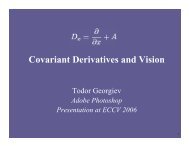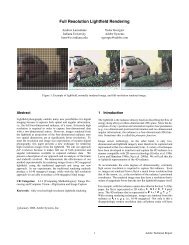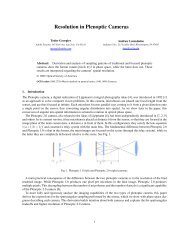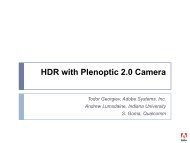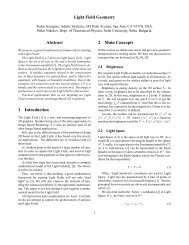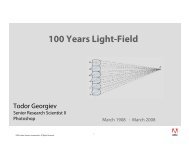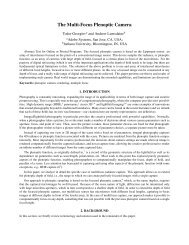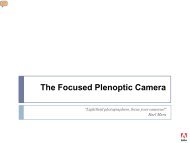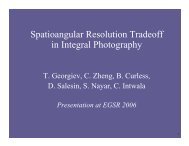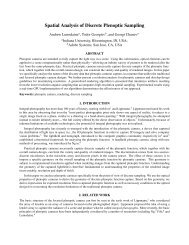Covariant Derivatives and Vision - Todor Georgiev
Covariant Derivatives and Vision - Todor Georgiev
Covariant Derivatives and Vision - Todor Georgiev
You also want an ePaper? Increase the reach of your titles
YUMPU automatically turns print PDFs into web optimized ePapers that Google loves.
60 T. <strong>Georgiev</strong><br />
If the image is defined as a section in a fibred space, the above definition of<br />
gradient does not work because in fibred spaces there is no concept of derivative<br />
or “comparison between different fibres”. Perceptually the situation is similar.<br />
We do not have a sense of comparison between the lightness of different pixels in<br />
the image before assuming some adaptation of the visual system. Pixels are just<br />
“records” without interpretation. In order to compare pixels we need an additional<br />
structure. In our mathematical model this structure is called connection.<br />
A connection on a bundle (E,π,B), where B denotes the image plane, is a<br />
mapping, or a rule, that for any section σ on E produces what is called the x <strong>and</strong><br />
y components of the covariant gradient of that section. These components are<br />
also sections. This mapping has certain properties similar to the properties of<br />
the gradient. In order to come up with a natural definition, let’s look again at the<br />
case of functions. If f = f(x, y) <strong>and</strong>s = s(x, y) are functions on B, the derivative<br />
of the product fs in direction x would be ∂<br />
∂<br />
∂<br />
∂x (fs)=( ∂xf)s + f ∂xs,whichis known as the Leibniz rule for derivative of a product. A similar expression is<br />
valid for the y derivative.<br />
The concept of connection is a generalization of the above Leibniz rule to the<br />
case of sections. By definition, if D is a connection, Dx(fσ)=( ∂<br />
∂xf)σ + fDxσ.<br />
Note that the derivative ∂ acts on a function, while the “derivative” acting on<br />
∂x<br />
the section is Dx. Similar expression is valid for y.<br />
In our image processing applications, a color picture is a section in a vector<br />
bundle, where each three dimensional fibre is a copy of the vector space of<br />
colors. A connection is “adapted (covariant) gradient of color”, as perceived by<br />
the observer. In other words, it shows how the human visual system in a given<br />
state of adaptation perceives directional change of color.<br />
Any section can be represented as a linear combination of a set of basis sections<br />
σi. Inotherwords,σ = Σfiσi. Summation is assumed over i =1, 2, 3, <strong>and</strong> the<br />
coefficients f i are functions. These functions are referred to as color channels<br />
(Photoshop terminology).<br />
By the above definition of connection, Dx <strong>and</strong> Dy would act on a section<br />
σ = Σfiσi in the following way:<br />
Dxσ = DxΣ(f i σi) =Σ(( ∂<br />
∂x f i )σi + f i Dxσi) (1)<br />
Dyσ = DyΣ(f i σi) =Σ(( ∂<br />
∂y f i )σi + f i Dyσi) (2)<br />
These expressions simply extend the Leibniz rule for the action of derivatives<br />
on functions to a Leibniz rule for sections. We don’t know what the action on<br />
the basis section σi is, but we know that the result must be again a section,<br />
representable by the basis. So, it is Dxσi = ΣAj ixσj where Aj ix is some matrixvalued<br />
function of x <strong>and</strong> y. Similar for Dy <strong>and</strong> Aj iy.<br />
DxΣ(f i σi) =Σ(( ∂<br />
∂x f i )σi + Σf i A j ixσj) (3)<br />
DyΣ(f i σi) =Σ(( ∂<br />
∂y f i )σi + Σf i A j iyσj) (4)



